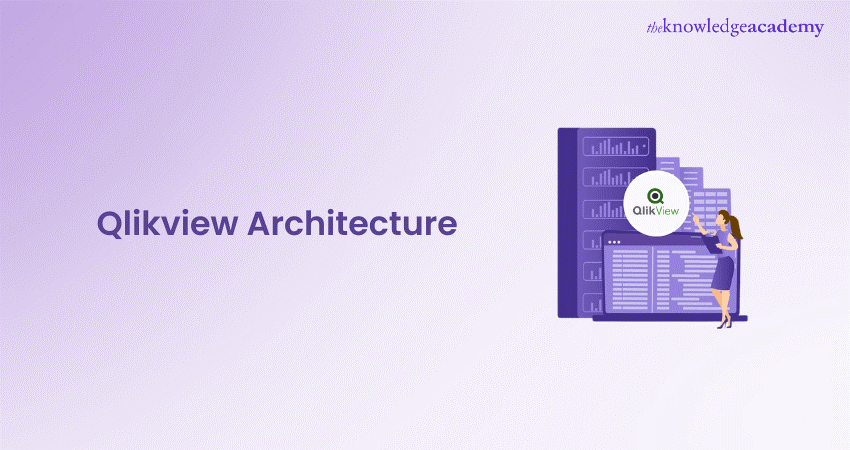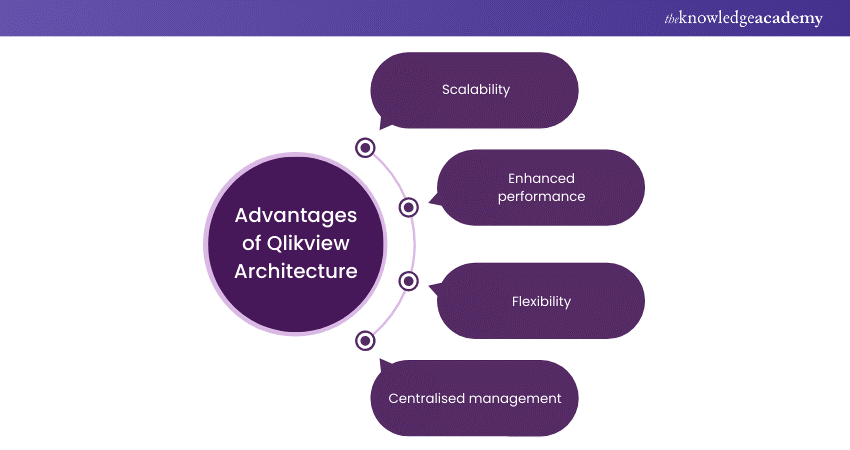We may not have the course you’re looking for. If you enquire or give us a call on +44 1344 203 999 and speak to our training experts, we may still be able to help with your training requirements.
We ensure quality, budget-alignment, and timely delivery by our expert instructors.

The ever-evolving landscape of business intelligence requires organisations to consistently seek out inventive approaches to problem-solving. Because of its robust architecture and exceptional functionality, Qlikview is among the most powerful and versatile tools available. Qlikview is not merely a data visualisation tool; rather, it empowers businesses to confidently make data-driven decisions. To fully realise the potential of Qlikview Architecture and harness the transformative power of data, one must thoroughly understand it.
Hence, this blog will help you explore the various components of Qlikview Architecture. You'll have a comprehensive understanding of its capabilities and functionalities by investigating the basic layers up to the advanced features. Let's explore this blog to learn the secrets of its exceptional performance and game-changing skills.
Table of Contents
1) What is Qlikview Architecture?
2) How Does Qlikview Work?
3) The Three-Tier Architecture of Qlikview
4) Significance of Qlikview Architecture
5) Conclusion
What is Qlikview Architecture?
Qlikview Architecture refers to the structural framework that underpins the functionality and capabilities of the Qlikview platform. By comprehending the intricacies of this architecture, users can effectively leverage its full potential to derive actionable insights from their data.
At the heart of Qlikview's architecture lie its key components, which collectively contribute to its functionality and effectiveness. Let’s explore how these components play a unique role in the Qlikview ecosystem:
1) Qlikview desktop
Strong data visualisation and analysis solutions are built on top of Qlikview Desktop. Data loading from multiple sources, such as databases, spreadsheets, and web services, is one of its primary features. Developers can model and manipulate data with Qlikview Desktop to produce a single data model.
This procedure entails organising data to enable effective analysis and investigation. Before providing data to end users, developers can utilise numerous transformation techniques to clean, alter, and improve the quality of the data. To explore similar capabilities in a modern environment, understanding Qlik Sense Desktop installation can help users transition to a more advanced self-service analytics platform.
2) Qlikview server
Qlikview Server serves as the backbone of the Qlikview ecosystem, providing a centralised platform for hosting and managing Qlikview applications. Its primary function is to facilitate access to applications for end-users, whether they are accessing them through a web browser or the Qlikview Desktop client. This centralised access ensures that users can securely access the latest version of applications from anywhere, at any time.
Along with these, Qlikview Server protects sensitive data and ensures compliance with regulatory requirements. Its distributed architecture allows organisations to scale their deployments horizontally by adding additional servers as needed.
Discover the power of QlikView! Click here to learn how this robust BI tool transforms your data into actionable insights.
3) Qlikview publisher
By automating Qlikview application distribution and management, Qlikview Publisher enhances the features of Qlikview Server. Scheduling reloads of data from several sources is one of its essential features. Developers and administrators are freed up to work on other important projects by using Qlikview Publisher to automate the data refill process.
Furthermore, guaranteeing that all Qlikview apps are updated helps preserve data accuracy and consistency. Above all, Qlikview Publisher improves Qlikview deployment performance and scalability.
Get ready to impress with our comprehensive list of QlikView interview questions and answers.
4) Qlikview management console
The Qlikview Management Console serves as the centralised administration hub for managing Qlikview Server deployments. It gives administrators a web-based interface to perform various administrative tasks efficiently. The Qlikview Management Console also facilitates application deployment by providing administrators with tools to publish, reload, and distribute Qlikview applications.
Apart from these, the Management Console offers license management capabilities. As a result, administrators can track license usage and revoke licenses as needed to optimise license utilisation and compliance.
Transform into a data-driven leader in your field. Join our Qlikview Training now!
5) Qlikview user access
Qlikview provides multiple ways for end users to engage with Qlikview apps. The Qlikview Desktop client is one of the main entry points that offers an extensive and dynamic data analysis environment. Next, it uses Qlikview AccessPoint to offer web-based access.
Additionally, Qlikview allows users to access apps from smartphones and tablets by providing mobile access with Qlikview Mobile. Above all, the Qlikview User Access supports access via third-party applications and platforms through APIs and integration capabilities.
Unlock the potential of your data with Qlik Sense! Learn about its features and how it can elevate your business intelligence strategy. Click to find out more!
How does Qlikview work?
Understanding the workflow of Qlikview is essential for grasping its functionality and capabilities. Qlikview operates through three main stages:

1) Data source end
At the data source end, Qlikview connects to various data sources like databases, spreadsheets, or web services to extract data. It can look after both structured and unstructured data from multiple sources, providing flexibility in data integration.
2) Back end
In the back end, Qlikview processes and transforms the extracted data into a format optimised for analysis. This includes data cleansing, transformation, and modelling to create a unified data model that supports efficient data exploration and visualisation.
3) Front end
The front end of Qlikview encompasses the user interface where users interact with data. It includes features such as interactive dashboards, charts, and tables that enable users to explore data, discover insights, and make data-driven decisions.
Equip yourself with essential Qlik Sense interview questions to boost your confidence.
The three-tier Architecture of Qlikview
Qlikview's architecture is structured around a three-tier framework, each layer playing a crucial role in the data analysis process. Let’s talk about the framework in detail:
1) Load layer
At the load layer, data is extracted from diverse sources and transformed into Qlikview's in-memory data model. This layer handles the ETL (Extract, Transform, Load) processes, ensuring that data is cleansed, structured, and optimised for analysis. By preparing data for consumption, the load layer sets the foundation for accurate and efficient data analysis within Qlikview.
Unlock Hidden Features! Check Out Our Qlik Sense Tips and Tricks for Smarter Data Visualization!
2) Transform layer
In the transform layer, data undergoes further transformation and aggregation to create a unified data model tailored for analysis. This layer enables users to perform associative data analysis, exploring dynamic relationships between data points. By aggregating and structuring data intelligently, the transform layer enhances the analytical capabilities of Qlikview, empowering users to uncover valuable insights and patterns.
3) Presentation layer
The presentation layer serves as the interface through which users interact with the data. It encompasses intuitive visualisations and user interfaces, including charts, graphs, and interactive dashboards. By presenting data in a visually compelling and easy-to-understand manner, the presentation layer facilitates data exploration and analysis for users of all levels of expertise. This layer empowers users to derive actionable insights from their data, driving informed decision-making and strategic initiatives.
Gain in-demand skills and unlock new opportunities with our Business Intelligence Analyst Course – register today!
Significance of Qlikview Architecture
The architecture of Qlikview plays a significant role in its effectiveness as a business intelligence solution. Some key benefits of Qlikview Architecture include:

a) Scalability: Qlikview's distributed architecture is designed to accommodate the scalability needs of organisations. By distributing workloads across multiple servers, Qlikview can efficiently handle increased data processing demands without sacrificing performance or reliability. This scalability ensures that organisations can continue to derive value from Qlikview as their data needs evolve, making it a sustainable solution for long-term growth and expansion.
b) Enhanced Performance: Qlikview's in-memory data processing engine is a key factor in its exceptional performance capabilities. By storing data in memory rather than accessing it from disk, Qlikview can deliver lightning-fast response times, even when analysing large datasets. This enables users to interact with data in real-time, explore trends, conduct ad-hoc analysis, and derive insights without experiencing delays or latency. The high-performance nature of Qlikview's data processing engine enhances user productivity and enables organisations to make faster, data-driven decisions.
c) Flexibility: Qlikview's Architecture offers unparalleled flexibility, allowing organisations to integrate data from different sources and adapt to changing business requirements. Whether it's structured data from databases, unstructured data from text files, or real-time data streams from Internet of Things (IoT) devices, Qlikview can seamlessly integrate and analyse diverse data types. Additionally, Qlikview provides flexibility in data modelling and visualisation, empowering users to create customised data models and visualisations that meet their specific needs. This flexibility enables organisations to extract maximum value from their data assets and drive innovation across the enterprise.
d) Centralised management: Qlikview's centralised management console is a cornerstone of its architecture, which allows administrators to manage all aspects of their Qlikview deployments. From user management to application deployment, the management console streamlines administrative tasks and ensures consistent governance across the organisation. This centralised approach enhances operational efficiency, reduces administrative overhead, and ensures the reliability and security of Qlikview deployments.
sed between QlikView and Qlik Sense? Get the insights you need to make an informed decision! Click here for a detailed comparison.
Conclusion
As a business tool, Qlikview Architecture optimisation requires a thorough understanding of its design. By comprehending this Architecture and its essential elements, organisations can extract meaningful insights from their data and facilitate well-informed decision-making.
Transform your data into actionable insights with Business Objects Reporting Training – join us now!
Frequently Asked Questions
What distinguishes Qlikview from other BI platforms?

Qlikview stands out for its associative data model, enabling dynamic data exploration. Unlike traditional BI tools, it offers in-memory processing for faster analysis and a user-centric approach to data visualisation. By doing so, it empowers users to discover insights effortlessly.
How does Qlikview ensure data security?

Qlikview stands out for its associative data model, enabling dynamic data exploration. Unlike traditional BI tools, it offers in-memory processing for faster analysis and a user-centric approach to data visualisation. By doing so, it empowers users to discover insights effortlessly.
What are the other resources and offers provided by The Knowledge Academy?

The Knowledge Academy takes global learning to new heights, offering over 3,000 online courses across 490+ locations in 190+ countries. This expansive reach ensures accessibility and convenience for learners worldwide.
Alongside our diverse Online Course Catalogue, encompassing 19 major categories, we go the extra mile by providing a plethora of free educational Online Resources like News updates, Blogs, videos, webinars, and interview questions. Tailoring learning experiences further, professionals can maximise value with customisable Course Bundles of TKA.
What is the Knowledge Pass, and how does it work?

The Knowledge Academy’s Knowledge Pass, a prepaid voucher, adds another layer of flexibility, allowing course bookings over a 12-month period. Join us on a journey where education knows no bounds.
What are related courses and blogs provided by The Knowledge Academy?

The Knowledge Academy offers various Business Intelligence Reporting Courses, including Qlikview Training, Tableau Desktop Training, and DAX Training. These courses cater to different skill levels, providing comprehensive insights into Qlikview vs Qlik Sense.
Our Office Applications Blogs cover a range of topics related to Qlikview Architecture, offering valuable resources, best practices, and industry insights. Whether you are a beginner or looking to advance your Office Application skills, The Knowledge Academy's diverse courses and informative blogs have got you covered.
Upcoming Office Applications Resources Batches & Dates
Date
 QlikView Training
QlikView Training
Fri 25th Apr 2025
Fri 20th Jun 2025
Fri 22nd Aug 2025
Fri 17th Oct 2025
Fri 19th Dec 2025






 Top Rated Course
Top Rated Course



 If you wish to make any changes to your course, please
If you wish to make any changes to your course, please


